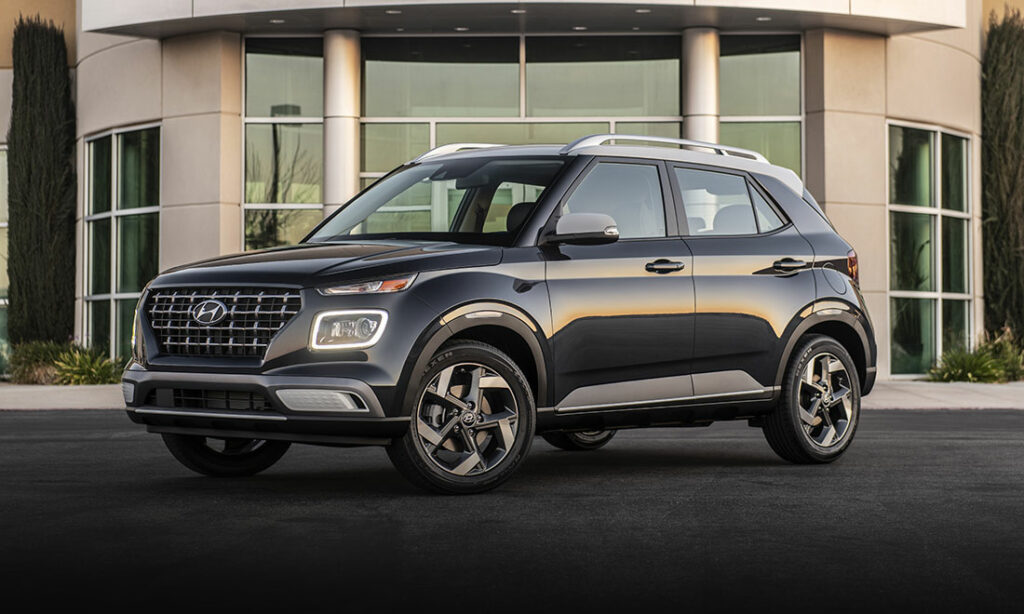Toyota Prius Generations: Through the Years
The Prius arguably got the automotive “going green” conversation started over 20 years ago. Four Toyota Prius generations later, it’s still going strong.
Looking Back at Previous Toyota Prius Models
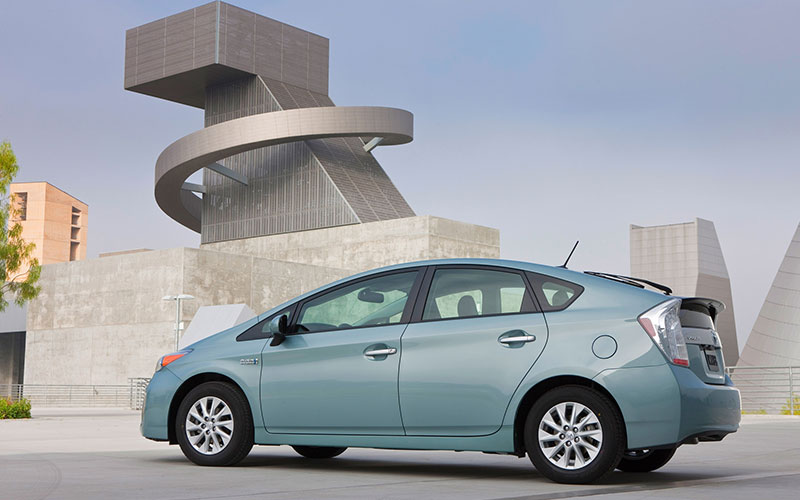
2012 Toyota Prius – pressroom.toyota.com | Shop Toyota Prius on Carsforsale.com
There is a lot of news these days on cars “going green” and bragging about the latest efficiencies and electric powerplants. But the Toyota Prius arguably got the conversation started more than 20 years ago. The Prius first appeared on Japanese roads in 1997, landing here in the United States for the 2000 model year. While the Honda Insight technically hit US shores before the Prius, it stumbled thanks to oddball looks and tiny size. Toyota quickly surpassed Honda on the hybrid electric vehicle sales front and has gone on to produce four Toyota Prius generations since then.
Toyota kicked off the hybrid segment with the Prius’ combined hybrid configuration meaning it can run on gas, electricity or both. In fact, Prius is Latin for “first” or “original”. Now sold in 90 markets worldwide with more than 6 million cumulative units sold, the Prius represents an important historical building block in the ever-growing push to wean cars off fossil fuel. With an EPA estimated city fuel economy figure of 58 miles per gallon (mpg) for the 2021 Prius L Eco, it’s fair to say the Prius is doing its part. Let’s look at how Toyota Prius generations have evolved over the years.
First Generation Toyota Prius (1997 – 2003)
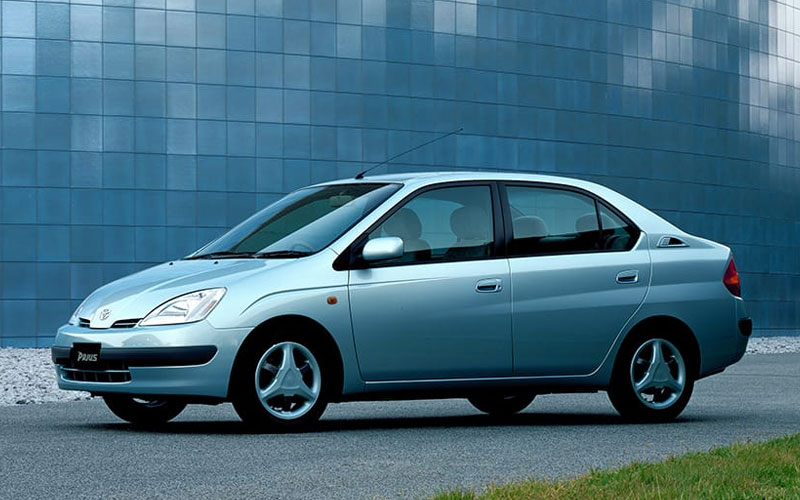
- 1997 marks year one of the Prius in Japan (though it wasn’t until 2000 that American drivers could buy one). The two new models for Toyota were the 1998 Tundra and the 1998 Prius.
- The first Toyota Prius model was designated internally as the NHW10. This first-generation Prius generation was marketed as “Just in time for the 21st Century”, debuting with a 1.5-liter inline- engine that joined with a battery-powered electric motor.
- The Prius could run on electricity only, promoting its agenda of reducing dependence on fossil fuels.
- The Toyota design team chose to place the motor alongside the engine so that it was suited for mass production on an assembly line.
- Japanese media outlets were reporting that the NHW10 could get 65 mpg, but, in reality, designers hadn’t reached that point, or even knew if it was possible. In low-load conditions, Toyota eventually did reach that mark with the NHW10.
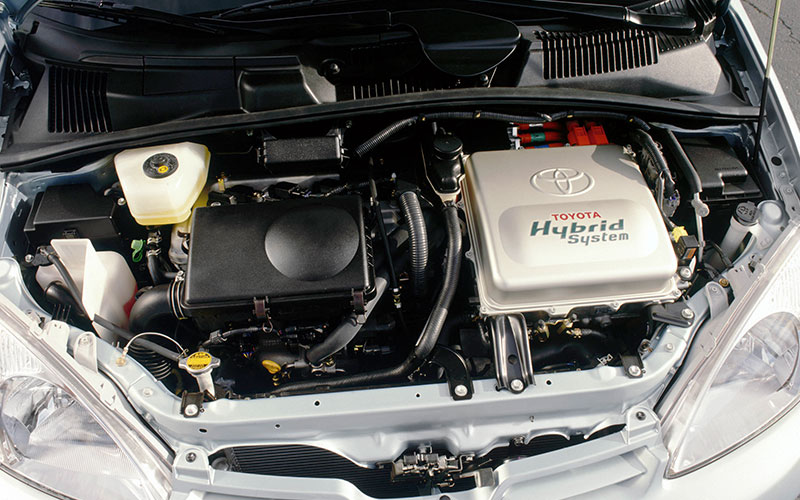
- Production of the NHW10 model in Japan lasted from December 1997 to February 2000. A total of 37,425 vehicles were produced.
- The Toyota Prius NHW11 was sold outside of Japan in 2000. Gen-one Priuses were designed as a sort of notchback 4-door sedan, positioned in pricing at $19,995, between Toyota’s Corolla and Camry.
- With a 1.5-liter all-aluminum gasoline engine, the 2001 Prius made 70 horsepower, up from the Japanese NHW10 models. It also made 82 lb-ft of torque. A continuously variable transmission (CVT) drove power to the front wheels.
- That engine partnered with a nickel-metal hydride battery pack, which supplied the electric motor with 25 kilowatts (kW) of energy. It provided an additional 44 horsepower.
- In ideal conditions, the 2001 Toyota Prius was estimated to get 52 mpg in the city and 45 mpg on the highway.
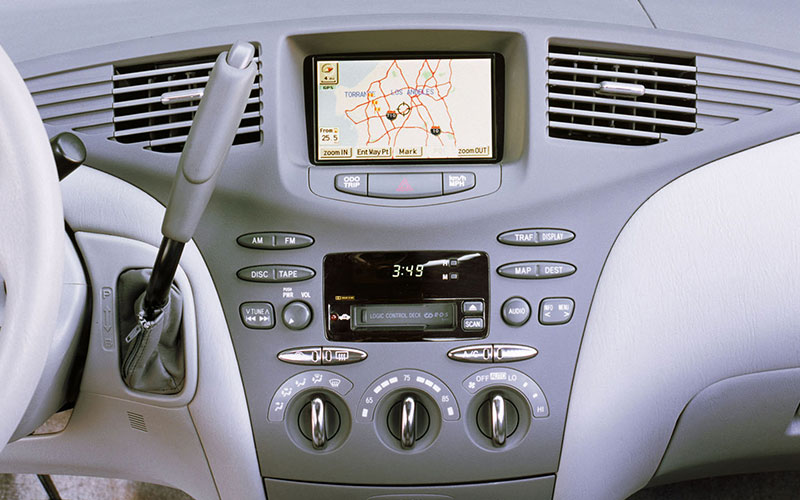
- The 2001 Prius met the required emissions standards to be designated as a Super ultra-low emission vehicle (SULEV) thanks, in part, to variable valve timing with intelligence. This system helped maximize engine efficiency while also minimizing emissions.
- Toyota used a combination of wind-cheating sheet metal, more efficient systems, and regenerative braking to hit these mileage targets. For instance, the water pump ran on electricity instead of the more typical serpentine belt, to eliminate friction losses.
- It was because of the SULEV classification made by the Environmental Protection Agency (EPA) that owners of the XW10 Prius were able to qualify for a $2,000 income tax deduction. The Prius was the first vehicle to qualify for that.
- Several new optional features were added to the 2002 Prius, including new colors, a navigation system, cruise control, and daytime running lights.
- There were no changes to the 2003 Toyota Prius, the last model of the first generation.
Second Generation Toyota Prius (2004 – 2009)
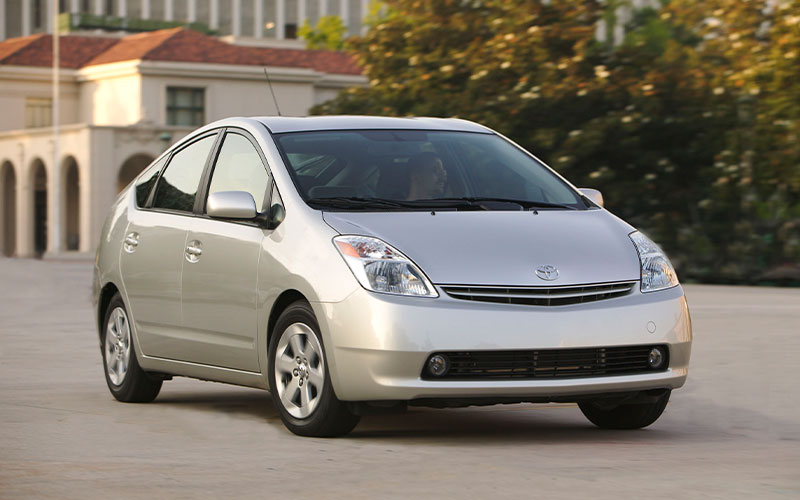
- Marked by a complete redesign, the 2004 Toyota Prius, otherwise known as the XW20, ushered in a unique look that all Prius generations since then have maintained.
- A noticeable change was the Kammback design, defined by the back glass sloping down and ending abruptly with a vertical surface.
- Another change in the 2004 redesign was what Toyota coined a “triangle silhouette,” where the apex of the vehicle is above the driver’s head with similar slopes running to the front and rear.
- The looks were improved and so were the aerodynamics, including a slippery 0.26 drag coefficient.
- Toyota filed more than 530 vehicle patents for exclusive technology that was used to boost efficiency and increase fuel economy.
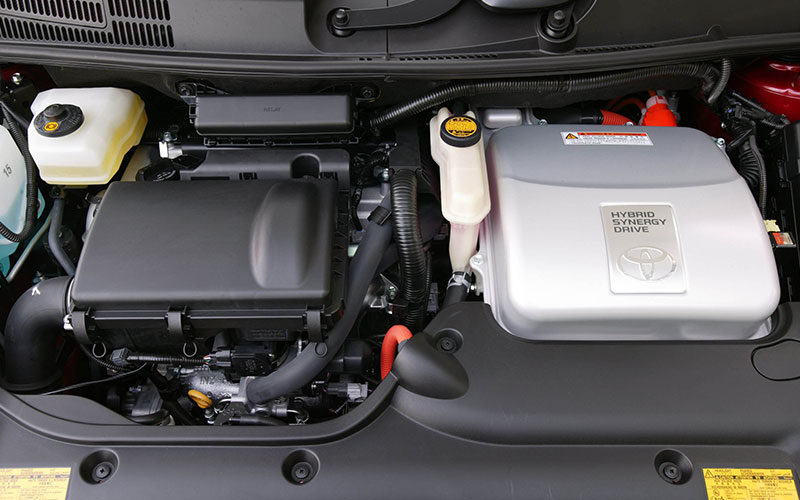
- The second Toyota Prius generation was equipped with Toyota’s Hybrid System II. The 2004 Prius reached 48 mpg. Toyota was able to do this because of changes like using an industry-first all-electric air conditioning compressor, and an even lighter weight nickel metal hydride battery pack than before.
- The California Air Resources Board also certified the Prius as an Advanced Technology Partial Zero Emission Vehicle.
- The small number of changes in the 2005 Toyota Prius include making the rear wiper standard. A tire pressure monitor, an optional backup camera, and new headlights were added to the 2006 Toyota Prius.
- There was a nice little upgrade that came with the 2007 Prius. It was outfitted with a larger rear spoiler, foglamps, 16-inch alloy wheels, and a sport-tuned suspension.
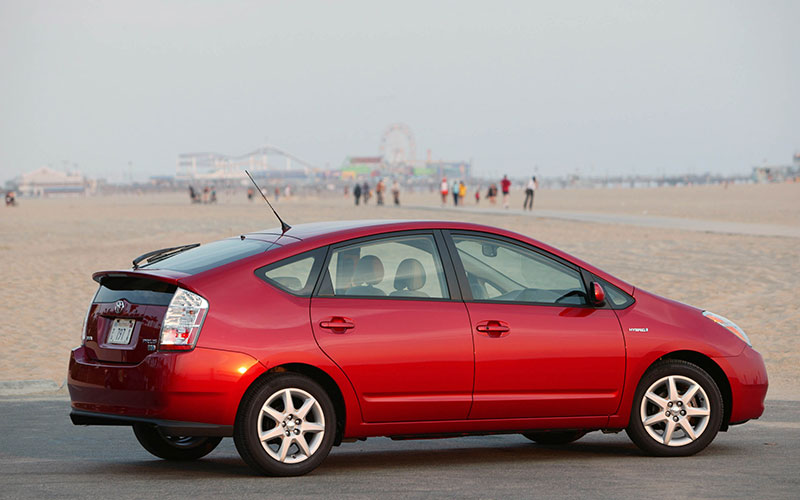
- The 2007 model was the first that offered two trim levels: the base or the Touring.
- At this point, the Toyota Prius was producing 76 horsepower and 92 lb-ft of torque with its gasoline 1.5-liter engine. The electric-drive motor provided an additional equivalent of 67 horsepower and 295 lb-ft of torque, but the 2007 Prius maxes out at 110 horsepower because the power sources hit their peaks at different times.
- Sales were accelerating throughout the early 2000s, eventually hitting 1 million global units sold in 2008.
- For the 2008 model, Toyota added another trim level. Not only was the Prius available at the base and Touring levels, but it was also offered in a standard Prius trim. The standard was a minimalized, cheaper version that didn’t have heated mirrors or cruise control.
- The 2009 Prius was the last model of the second generation. There were no big updates made to this model.
Third Generation Toyota Prius (2010 – 2014)
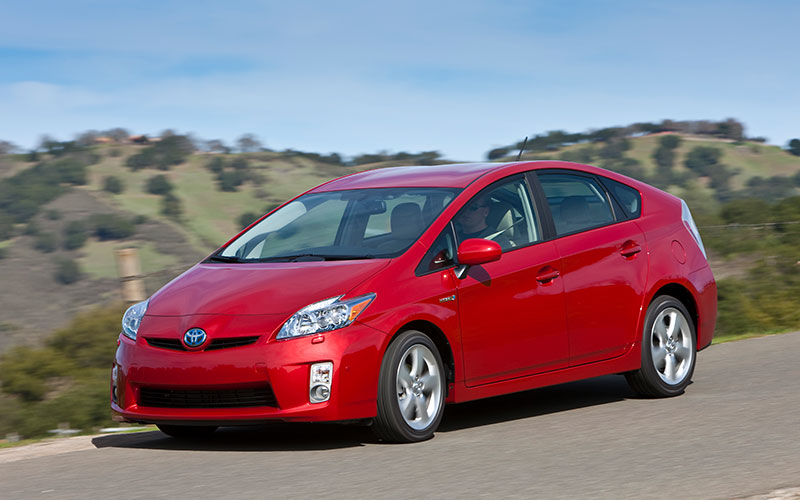
- A full redesign was part of the 2010 Toyota Prius, also known as the XW30. While the third Toyota Prius generation didn’t change much in terms of styling, it did receive powertrain upgrades, new body styles, and other improvements.
- The 4-cylinder gas motor increased displacement from 1.5 liters to 1.8 liters for an additional nearly 100 hp, bringing the 0-60 time closer to 10 seconds. The total output for the 2010 Prius was 134 horsepower.
- On the electric front, Consumer Reports examined the longevity and replacement cost of the Prius battery pack. They found 200,000 miles to be the approximate lifetime and a cost ranging from $500 (for low-use salvage yard batteries) to around $2,500 (for dealer replacement).
- Furthering the environment-focused ethos, third-generation XW30 Priuses used plant-derived ecological bioplastics for the interior trim which used wood- or grass-based raw material instead of petroleum.
- 2011 Prius models didn’t bring any changes with them, but the results of a 2011 public poll determined that the plural of Prius should be, “Prii.”
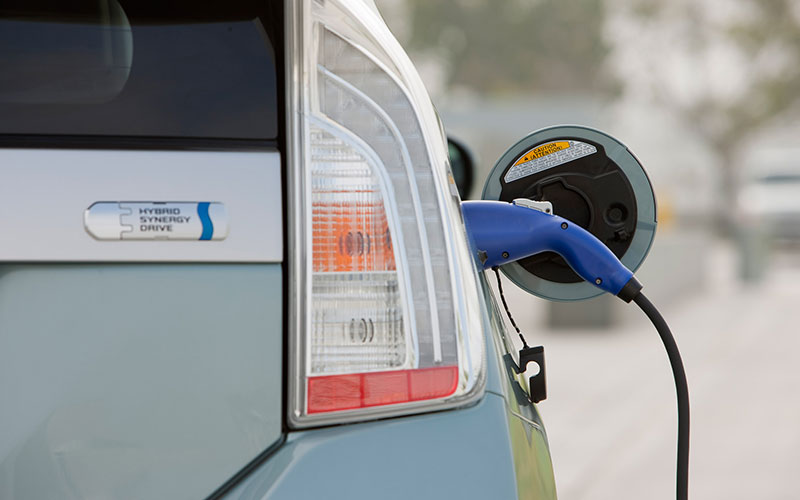
- The 2012 Toyota Prius expanded its lineup to include the Prius V, Prius C, and Prius Plug-In Hybrid.
- The Prius V was effectively an extended wagon-style version of the standard Prius, allowing for 50% more interior space. At the other end of the size scale, the Prius C was closer in dimension to Toyota’s Yaris which meant lower pricing.
- 2012 models also marked the first time Toyota offered a plug-in hybrid version. The Prius PHV swapped the NiMH battery for a lithium-ion pack that could be fully charged in 3 hours from a 110-volt household plug.
- Worldwide Prius sales topped the 3-million-unit mark by June 2013.
- To see how well the car matches up against the competition, we wrote a budget buy: 2013 Toyota Prius vs Honda Insight for under $10,000.
- Toyota introduced another new trim level for the 2015 Prius, the Persona Series Special Edition. This trim came with 17-inch alloy wheels, dark chrome interior accents, and synthetic leather upholstery that was black with red stitching.
Fourth Generation Toyota Prius (2015 – Present)
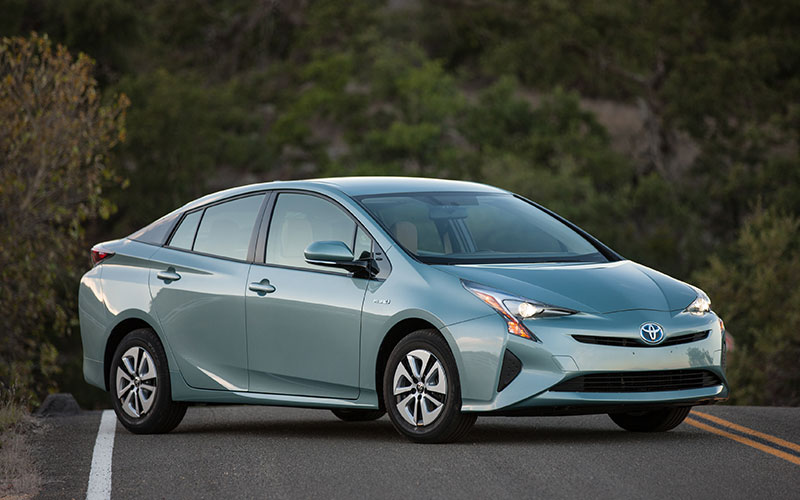
- The XW50 Prii kicked off the fourth generation with a revised look. The signature Prius “triangle silhouette” remains, but it incorporates a more aggressive front-end design and, overall, a more sculpted look.
- At the start of the fourth generation, the 2016 Prius lineup included the Prius Two, Prius TwoEco, Prius Three, Prius Three Touring, Prius Four, and Prius Four Touring.
- 2016 Prius models arrived on an all-new platform, the Toyota New Global Architecture (TGNA), bringing a host of improvements like a lower center of gravity, a 60% increase in structural rigidity thanks to new welding and adhesive techniques, and firewall sound-proofing that matches engine noise frequency to cancel it out.
- Lighter hybrid components increased fuel efficiency to 54 mpg in the city and 50 mpg on the highway, but the 2016 Prius did drop to 121 horsepower from 134 horsepower in the previous model.
- Some new options include an 11.6” multimedia interface, a color head-up display, and wireless charging.
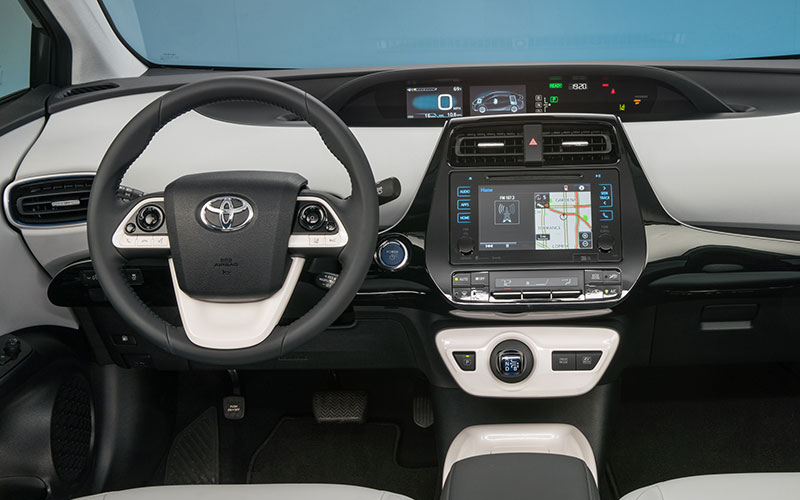
- The second-row legroom in the 2016 Prius was decreased to 33.4” from 36.0” in the 2015 model. However, due to less legroom, Toyota was able to increase cargo space to 24.6 cu-ft in the 2016 model from 21.6 cu-ft in the 2015 model.
- The second-generation 2016 plug-in version was released under the Prius Prime name, achieving 133 miles per gallon equivalent when running in all-electric mode. This was the best rating at the time.
- One of the cars that made our list of the Best Used Hatchback Cars was the 2016 Prius, noted for its gas mileage, safety tech, and suspension.
- Toyota’s optional Safety Sense package became standard in the 2017 Prius. It included a pre-collision warning system with pedestrian detection, lane departure alert, automatic high beams, and dynamic radar cruise control.
- The Prius One trim level also debuted in the 2017 lineup. It was similar to the Prius Two, but didn’t have some minor features, like a rear windshield wiper.

- By January 2017, total global sales of models in the Prius family surpassed 6.1 million units.
- After no big changes to the 2018 Prius models, the 2019 Toyota Prius arrived with reorganized trim levels: the L Eco, the LE, the XLE, and the Limited. An all-wheel drive, or AWD-e, model was also introduced for the LE and XLE trims.
- The AWD-e added AWD ability via a dedicated rear axle electric motor, giving the Prius more of a foothold (pun intended) in the Snow Belt.
- The outside of the 2019 Prius was updated slightly with new front and rear bumpers, additional paint colors, and revised LED headlights and taillights.
- The 7″ center display that was available in previous models became standard on 2020 Prius models. All 2020 Toyota Prii also came with Apple CarPlay and Amazon Alexa capabilities.
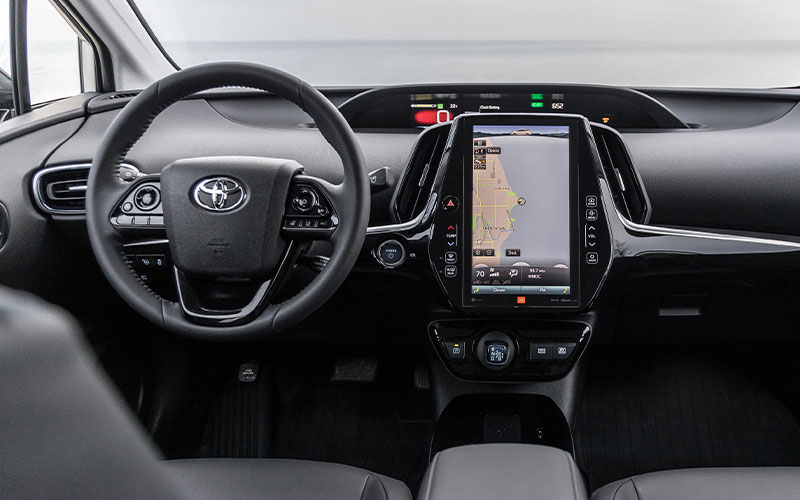
- The starting price for a base 2020 Toyota Prius was $24,200.
- Android Auto functionality was added to the 2021 Toyota Prius.
- The 2021 Prius lineup included a 2020 Edition trim level, which came with 17″ black-painted wheels, black exterior paint, black interior trim, and special floor mats.
- Although there weren’t many changes for the 2022 Prius, a new rear-seat reminder function was included.
- Also new was a Nightshade Special Edition, complete with black exterior accents and black alloy wheels. It was very similar to the 2020 Edition that was one of the 2021 models.
Fifth Generation Toyota Prius (2023–Now)
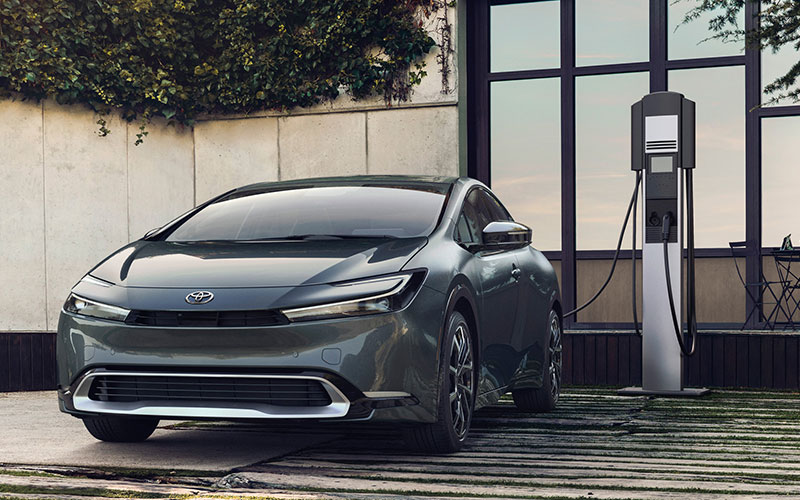
- You already got a sneak peek at the 2023 Toyota Prius, which launches the fifth generation of the car with more style than ever! The new design is leaner than it used to be.
- When it comes to performance, the 2023 Prius gets a boost. It now earns up to 196 horsepower in AWD with a 2.0-liter engine and electric motors.
- Unlike previous models, this Prius accelerates from 0 to 60 mph in 7 seconds.
- Toyota estimates that the latest Prius gets between 49 and 57 mpg in combined city/highway driving.
- The 2023 plug-in hybrid Prius Prime model has more range than before, too, getting between 544 and 644 miles with its lithium-ion battery pack.
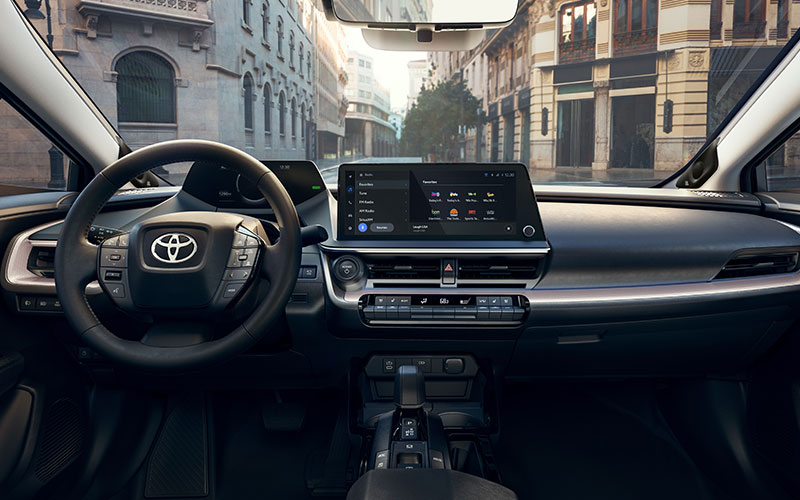
2023 Toyota Prius – pressroom.toyota.com | Shop Toyota Prius on Carsforsale.com
- Inside, there are also some new features. An 8″ touchscreen is standard, except for higher trims. They get 12.3″ displays.
- Part of the overhaul includes heated and ventilated seats, ambient lighting and a panoramic glass roof, too.
- Available as the LE, XLE, and Limited, the base LE trim will start with a sale price of $27,450.
- Unlike other generations of the Prius, the fifth-generation 2023 model won’t be sold in Australia, New Zealand, or the United Kingdom. This was a decision Toyota made based on low sales of previous models. Instead, the Corolla Hatchback Hybrid will be offered in those markets.
- The 2023 Prius models are just starting to arrive at dealerships this month. You can take a look at the best 2023 Prius deals that are available by looking at our updated listing of New Car Incentives.


